OCZ Vertex 4 256 GB and 512 GB Solid State Drives Review

About a month ago OCZ launched a completely new family of high-performance SSDs based around the proprietary Indilinx Everest 2 controller, and very recently they released new firmware version 1.4 for it, which was supposed to increase its speed even more. Will this make Vertex 4 the fastest consumer grade SSD with SATA 6 Gbps interface? Let’s find out!
OCZ Technology is a highly ambitious player on the market of solid state drives. They really seem to be willing to become the No.1 provider of consumer-class SSDs and put a lot of effort into this. The effort has been largely of the marketing nature. OCZ followed an aggressive advertisement strategy, waged price wars and deployed a wide-reaching dealer network. While fruitful, such activities couldn’t be fully efficient without some killer product that would be technically better than anything offered by the competitors. OCZ used to install third-party SandForce controllers in its desktop SSDs and the same controllers were also used by other manufacturers that produced similar products.
The tactical decision to buy out the entire first batch of controllers and release OCZ-branded SandForce-based SSDs ahead of competitors didn’t work out, either. It attracted some publicity to the brand but didn’t help increase sales in the long run. Moreover, being the first company to offer such products, OCZ was also the first to handle the backlash caused by the flaws and bugs in the original version of the controller and firmware.
Having learned from such bitter experience, OCZ changed its strategy and invested into its own controllers last year. They chose the Korean firm Indilinx they had already partnered with back in 2009: the Vertex SSD of the 2009 model year ran on Indilinx Barefoot controllers. The renewed collaboration proved fruitful as Indilinx engineers soon came up with an up-to-date Everest controller we recently tested using the Octane SSD. The Octane series isn’t a killer product, though. They are good enough by today’s standards but fall behind both top-end SSDs with second-generation SandForce controllers and many SSDs with Marvell controllers.
The second cycle of development seems to be better, though. Released soon after the original Everest, the Everest 2 controller is employed in the Vertex 4 series, OCZ’s top offer in the consumer class. OCZ obviously has high hopes regarding the Everest 2. Can SSDs with this controller become the long-awaited breakthrough for OCZ and a worthy opponent to SandForce-based products? We’ll try to answer this question in this review by benchmarking a couple of serially produced Vertex 4 SSDs.
Indilinx Everest 2: What’s New?
It’s been less than a half-year since the release of SSDs with the first-generation Everest controller, but the Everest 2, employed in the Vertex 4, is something more than just a revision. The second-generation Everest is dramatically different in everything, not only in its speed specs. To beat all other products available on the market, OCZ needed not just a fast SSD. Besides speed, users are interested in such important parameters as reliability and price, so the ideal SSD is supposed to offer an attractive combination of the three. Guided by OCZ, the Indilinx development team focused on introducing additional technologies to increase the service life of flash memory and improving error correction algorithms. The resulting Vertex 4 is absolutely different from the Octane.
That said, the foundation for all the improvements is the increased controller performance. The Everest was based on a 275MHz dual-core ARM processor whereas the Everest 2 clocks the same CPU core at 400 MHz. The developers have additionally improved the cache memory interface and algorithms and made the Everest 2 compatible with a larger DDR2/DDR3 buffer (up to 1 gigabyte). The cache buffer is utilized for both write and read operations because the new controller can perform data prefetching from flash memory. These enhancements ensure a twofold performance boost for I/O operations and 80% lower access latency.
So, the first and second Everest controllers are closely related. They are similar on the hardware level, the differences boiling down to higher clock rate and firmware optimizations. By the way, the hardware of the Indilinx controllers was originally based on technologies from OCZ’s close partner Marvell, and the Everest 2 has much in common with Marvell’s highly promising 88SS9187 chip, but Indilinx did introduce a number of innovations on the hardware and software levels.
One of the most notable ones is Ndurance 2.0 technology which helps increase the service life of an SSD irrespective of the type of flash memory. Being an important feature of the new controller, Ndurance 2.0 allows OCZ to provide a 5-year warranty on its products based on the Everest 2. That’s equal to the longest warranty period you can get with consumer-class SSDs today.
There are four constituent parts of this technology. First, it’s an improved ECC algorithm that helps correct up to 128 data bits per each kilobyte. Second, it’s an adaptive program and read algorithm which takes into account the peculiarities of different NAND memory types and different manufacturers to adjust the internal voltage in such a way as to reduce flash memory wear. Third, data checksums are duplicated and distributed among different NAND devices. And fourth, write amplification is reduced by means of data pre-caching and per-block write combining.
Following the Vertex 4, the Everest 2 controller is going to give birth to a whole family of variegated products. Supporting 8 memory channels with 16-way interleave, it allows building SSDs with up to 1 terabyte capacity using existing NAND chips, and this maximum capacity may be doubled in the future. The controller is already compatible with upcoming NAND memory types (1x-nanometer tech process and TLC). Thus, the Everest 2 seems to have been designed for a long stay on the market.
Closer Look at OCZ Vertex 4
So far, the Everest 2 is only employed in one OCZ product. It is the Vertex 4 SSD. Having acquired an exclusive high-performance SSD platform, OCZ wants to profit by the newness of it and only then deploy it everywhere. It is quite natural to position the first Everest 2 based SSD as a replacement to top-end SSDs with the second-generation SandForce controller: the Vertex 4 is superior to the Vertex 3 in its specs. The following table shows you the specs of 240/256-gigabyte Vertex series products of different generations.
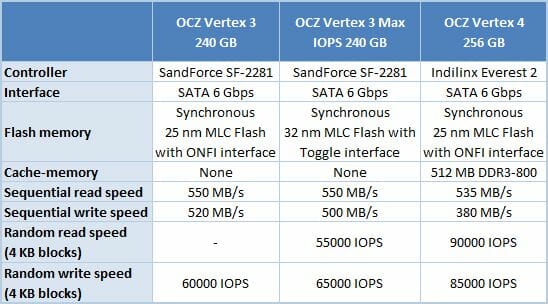
The high performance of the Everest 2 controller explains the superiority of the Vertex 4 over its predecessors at processing random-address data but the new SSD doesn’t look so good in terms of sequential operations. However, we should keep it in mind that, unlike the SandForce, the Everest 2 does not use any data compression, so its performance is consistent irrespective of data type. As opposed to that, the Vertex 3 series deliver varying performance which depends on data compressibility, so the numbers in their specs refer to the best possible scenario only. In other words, the Vertex 4 may turn out to be faster than the Vertex 3 series at sequential reading and writing in real-life applications.
The OCZ Vertex 4 series consists of four models with capacities of 64, 128, 256 and 512 gigabytes. As opposed to the Octane, there is no high-performance Vertex 4 with a capacity of 1 terabyte. Such a model is possible, though, and we may see it in the future. Right now OCZ is focused on promoting its Everest 2 based solutions as superior to the Vertex 3 series and other brands’ SandForce-based products.
The specs of the different Vertex 4 models are compared below:
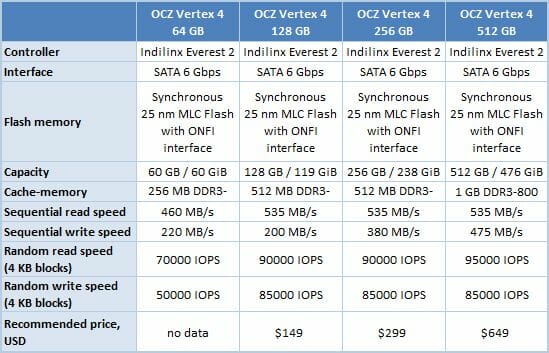
Like with many other SSD series, the performance of a Vertex 4 depends on its capacity. As you can see, the highest-capacity model is the fastest. It’s different from the Vertex 3 series in which the 240GB model is the fastest one.
As for pricing, the Vertex 4 series comes at $1.15-1.25 per gigabyte of storage, which is rather high. OCZ isn’t into dumping. They try to market their new product as a high-quality and high-performance SSD. At the same time, being now a developer and manufacturer of SSD controllers, OCZ has more elbowroom for price maneuvering, so we won’t be surprised if the Vertex 4 gets cheaper in response to some changes in the market situation, especially as there has already been a certain price cut after the announcement of the series.
The OCZ Vertex 4 is shipped in the standard gray-and-black cardboard packaging of the Vertex series which is now embellished with an “Indilinx Infused” logo. The accessories are conventional, too. Besides the SSD, the box contains a user manual, a promo sticker, and an adapter for installing the 2.5-inch SSD into a 3.5-inch disk bay of the system case.
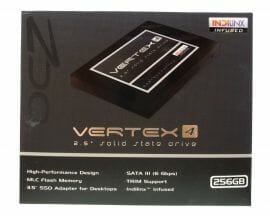
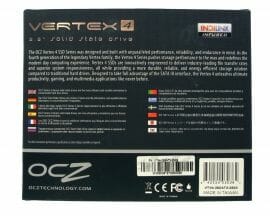
Except for the model name sticker, the Vertex 4 is no different externally from OCZ’s earlier products. Unlike most other brands of SSDs, OCZ ones do not have an all-metal case. The top panel is made of rather soft plastic.
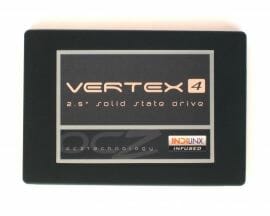
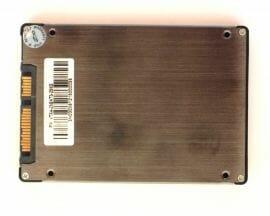
The PCB of the Vertex 4 features an original design.
OCZ Vertex 4 256 GB
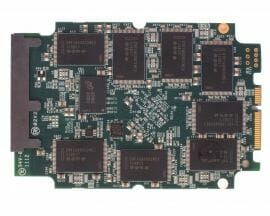
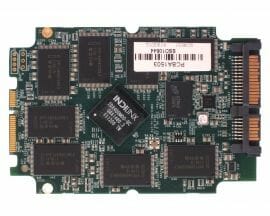
OCZ Vertex 4 512 GB
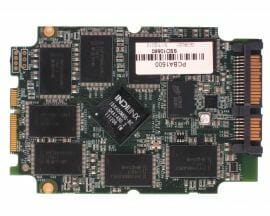
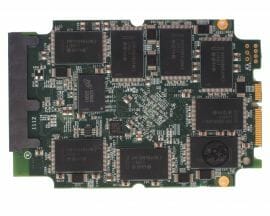
We can see that the Everest 2 controller is turned around by 45 degrees relative to the other chips. This solution is usually used to even out the length of interconnects to the memory chips for better synchronization.
Then, each memory chips is equipped with a dedicated multiplexor to enable interleaving.
The 256- and 512-gigabyte versions come with two 512MB DDR3-800 SDRAM chips of cache memory. The full 1 gigabyte is only used by the 512GB SSD whereas the 256GB Vertex 4 can only access half that amount for cache, the remaining half being unused. Take note of the supercapacitor next to one of the DDR3 SDRAM chips: it should keep the cache data safe in case of a power failure.
We can also note the consequence of the processor’s increased clock rate. There is a heat-conductive pad between the controller chip and the metallic part of the case. The Vertex 4 would get very hot during our tests.
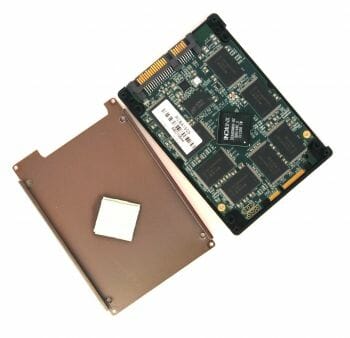
In fact, the new product from OCZ is the hottest SSD we’ve ever tested. It would even overheat in a cramped disk rack without active cooling: at high continuous loads the SSD would have problems sending data via Serial ATA interface, so the controller switched it to 3 Gbit/s mode.
While the fastest SSDs available today feature 32nm and 24nm Toggle NAND from Toshiba, OCZ employs somewhat cheaper synchronous flash memory manufactured by IMFT on 25nm technology. So, OCZ may eventually come up with a faster modification, something like Vertex 4 Max IOPS.
The 256GB Vertex 4 is equipped with Intel chips that have ONFI 2.2 interface. Each chip contains two 64-gigabit NAND devices. The 512GB variant has similar chips, each of which contains four semiconductor dies with flash memory. Thus, the Vertex 4 256GB uses 4-way interleave per channel whereas the higher-capacity variant uses 8-way interleave. That’s why the performance in the Vertex 4 series increases along with the capacity.
The Vertex 4 has no excessive reserve memory pool typical of SandForce-based solutions. Only 7.5 percent of the total capacity is not accessible for the user. It’s reserved for the Ndurance 2.0 technology.
OCZ offers the OCZ Toolbox software for managing SSDs. This utility helps update firmware, view SMART information and perform the Secure Erase command.
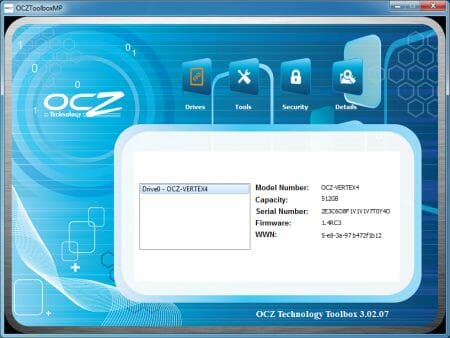
As is often the case, the first version of firmware for the Vertex 4 series was far from final. A month after the announcement the manufacturer released firmware version 1.4 which improved the speed of the new SSDs. It is as yet Release Candidate rather than official firmware, but we used it for our tests anyway. Here is the difference between the two firmware versions according to the AS SSD benchmark:
OCZ Vertex 4 256 GB
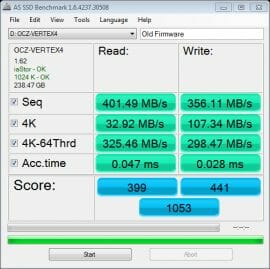
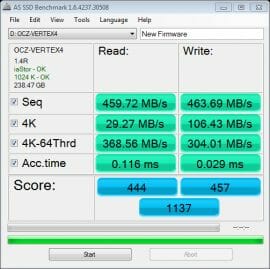
OCZ Vertex 4 512 GB
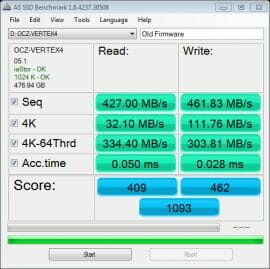
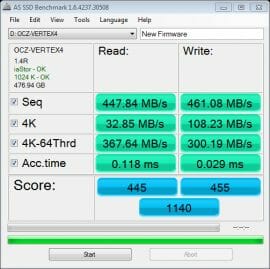
These changes will affect the specs. The specified sequential speeds are going to be increased.

The 128GB model speeds up the most, especially at writing, but we can also see substantial performance benefits in terms of read speed with the higher-capacity models. The benchmark results above suggest the same thing.
Testbed Configuration
All SSDs were tested in a system built around an Intel H67 based mainboard. This chipset provides support for two SATA 6 Gbit/s ports, which we use to connect the tested SSDs.
For our review OCZ Technology provided us with two most popular and fastest Vertex 4 models – 256 GB and 512 GB storage capacity. We will compare them against the competitor SSDs with the same storage capacity based on different Indilinx Everest 2 controllers. SandForce based products with 240 GB storage capacity were represented by a typical SSD with 32 nm Toggle NAND (OCZ Vertex 3 Max IOPS), a typical SSD with 25 nm synchronous ONFI memory (Corsair Force Series GT – analogue to OCZ Vertex 3), a typical SSD with 25 nm asynchronous memory (Corsair Force Series 3 – analogue to OCZ Agility 3) and a unique Intel SSD 520 Series using regular 25 nm synchronous memory but featuring exclusive firmware. The 512 GB Vertex 4 will be competing against 480 GB OCZ Vertex 3 with 25 nm synchronous ONFI memory. Moreover, we also included the results of an SSD based on Marvell 88S9174 controller – Corsair Performance Pro with 256 GB storage capacity and OCZ Octane 512 GB based on Indilinx Everest controller.
Overall our testbed was configured as follows:
- Intel Core i5-2400 (Sandy Bridge, 4 cores, 3.1 GHz, EIST and Turbo Boost turned off);
- Foxconn H67S mainboard (BIOS A41F1P03);
- 2 x 2 GB DDR3-1333 SDRAM DIMM 9-9-9-24-1T;
- Crucial m4 256 GB system disk (CT256M4SSD2);
- Tested SSDs:
- Corsair Force 3 Series 240 GB (CSSD-F240GB3-BK, firmware version 1.3.3);
- Corsair Force GT Series 240 GB (CSSD-F240GBGT-BK, firmware version 1.3.3);
- Corsair Performance Pro 256 GB (CSSD-P256GBP-BK, firmware version 1.0);
- OCZ Octane 512 GB (OCT1-25SAT3-512G, firmware version 1.13);
- OCZ Vertex 3 Max IOPS 240 GB (VTX3MI-25SAT3-240G, firmware version 2.22);
- OCZ Vertex 3 480 GB (VTX3-25SAT3-480G, firmware version 2.22);
- OCZ Vertex 4 256 GB (VTX4-25SAT3-256G, firmware version 1.4);
- OCZ Vertex 4 512 GB (VTX4-25SAT3-512G, firmware version 1.4).
- Microsoft Windows 7 SP1 Ultimate x64
- Drivers:
- Intel Chipset Driver 9.3.0.1019;
- Intel Graphics Media Accelerator Driver 15.22.54.2622;
- Intel Rapid Storage Technology 11.1.0.1006.
Performance
Random and Sequential Read and Write
We use CrystalDiskMark 3.0.1 benchmark to test the random- and sequential read and write speed. This benchmark is convenient to work with as it can measure the speed of an SSD with both incompressible random and fully compressible recurring data. This feature is important for testing SSDs based on SF-2281/2282 controller, which tries to compress the data before writing it into memory. So, there are two numbers in the diagrams below that reflect the maximum and minimum SSD speed. The real-life performance of an SSD is going to be in-between those two numbers depending on how effective the controller data compression is.
Note that the performance tests in this section refer to SSDs in their “Fresh Out-of-Box” state (FOB). No degradation could have taken place yet.
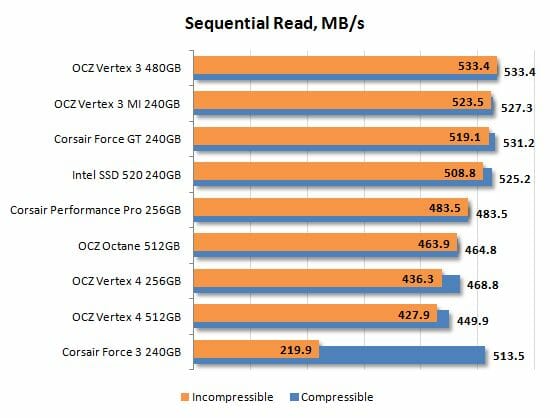
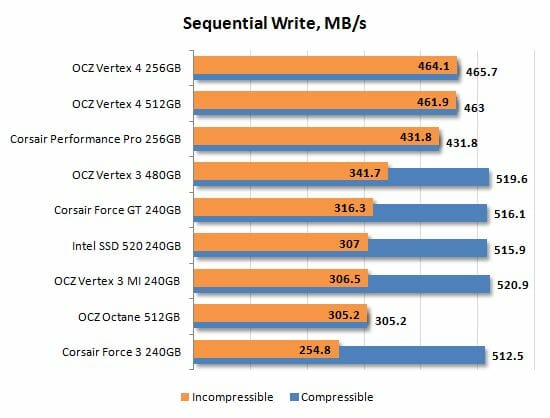
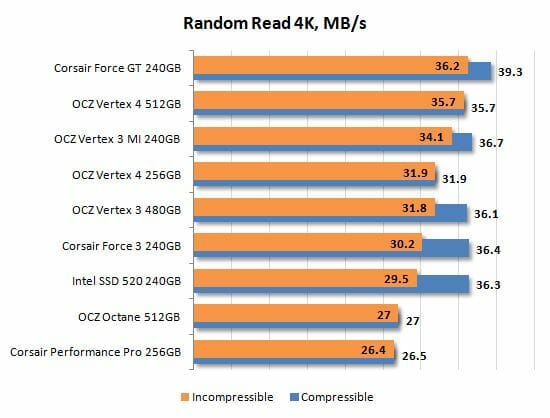
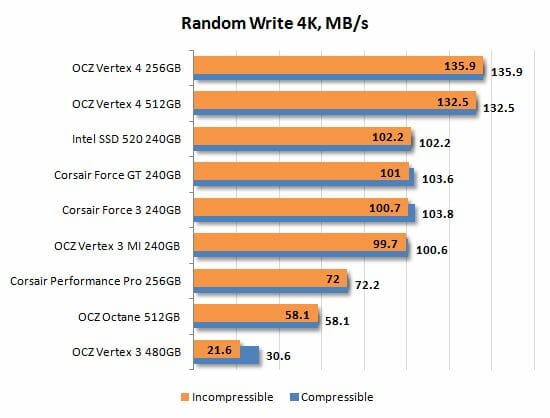
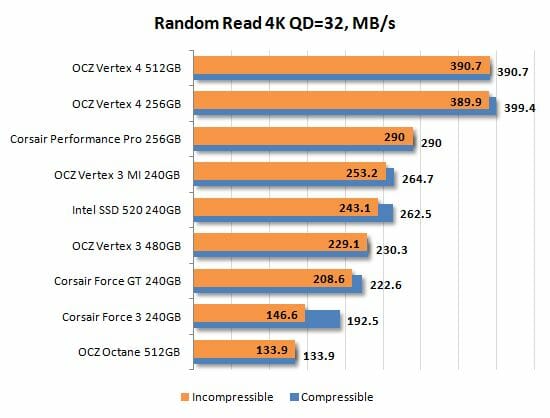
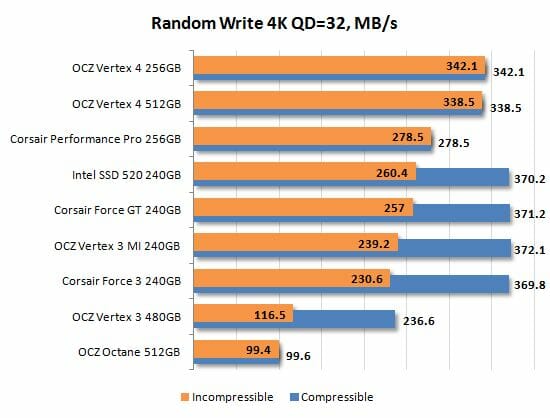
The problem with the Vertex 4 series is that their sequential read speed is too low. They are inferior in this parameter not only to the modern SSDs with second-generation SandForce controller and synchronous flash memory but even to their predecessor, the Octane SSD with the original Everest controller.
Apart from the results in the first diagram, the Vertex 4 series look really good. They can offer a record-breaking speed at any write operations as well as at random reading with a long request queue depth. When reading 4KB data blocks, which is a highly popular operation in practical applications, the Indilinx Everest 2 controller secures them second place, behind the Corsair Force GT, a typical SandForce-based SSD with synchronous memory.
Overall, the Vertex 4 series offers a combination of characteristics which are not quite typical of desktop solutions. It is not particularly good at reading but can beat any opponent at writing. Its reading performance improves at longer request queue depths, i.e. at high “intellectual” loads on the controller. This indicates that the computing part of the Everest 2 is indeed strong but its interaction with the flash memory interface is not as efficient as the SandForce’s. The cache memory helps to conceal this deficiency, but not quite well.
Degradation and Steady-State Performance
Unfortunately, SSDs are not always as fast as in their “fresh” state. In most cases their performance goes down after some time and in real life we deal with completely different write speeds than what we see on the diagrams in the previous chapter of our review. The reason for this phenomenon is the following: as the SSD runs out of free pages in the flash memory, its controller has to clear memory page blocks before saving data into them, which causes substantial delays. Although, modern SSD controllers can alleviate the performance drop by erasing unused flash memory pages ahead of time, when idle. They use two techniques for that: idle-time garbage collection and TRIM.
Of course, users are more interested in the consistent performance of their SSDs over a long period of time rather than the peak speed they are going to see only during the initial short-term usage period, while the drive is still “fresh”. The SSD makers, however, declare the speed characteristics of “fresh” SSDs for marketing reasons. That’s why we decided to test the performance hit that occurs when a “fresh” SSD becomes a “steady” one.
To get a complete picture of SSD performance degradation we ran special tests based on the SNIA SSSI TWG PTS (Solid State Storage Performance Test Specification) methodology. The main idea of this approach is to measure write speed consecutively in four different cases. First we measure the “fresh” SSD speed. Then we measure the speed after the SSD has been fully filled with data twice. The third test occurs after a 30-minute break during which the controller can partially restore performance by running the idle-time garbage collection. And finally, we measure the speed after issuing a TRIM command.
We ran the tests in synthetic IOMeter 1.1.0 RC1 benchmark, where we measured random write speed when working with 4 KB data blocks aligned to flash memory pages at 32 requests queue depth. The test data were pseudo-random.
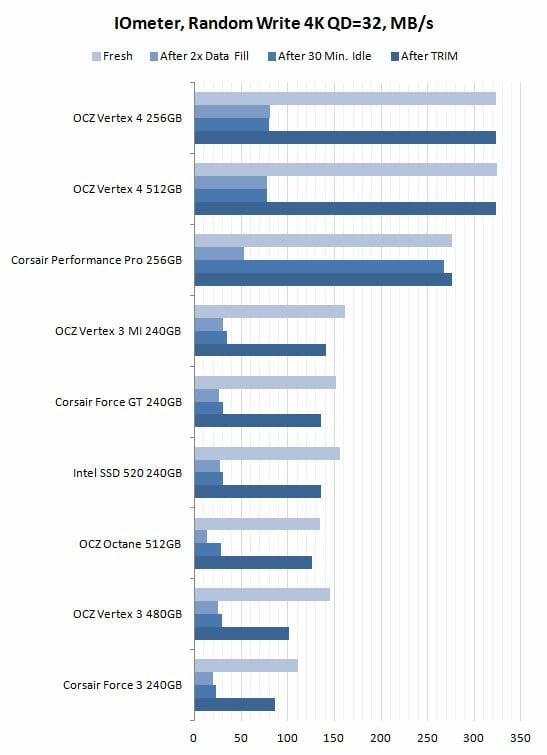
The results suggest that the OCZ Vertex 4 do not do background garbage collection but their TRIM implementation is excellent. After TRIM, their performance returns to the original level, as opposed to the numerous SandForce-based products. Thus, you are unlikely to see any performance degradation with a Vertex 4 SSD running under a TRIM-supporting OS, e.g. in an ordinary Windows 7 computer. Of course, there should be some free space on the SSD for TRIM to be effective.
Since the majority of SSDs do change their characteristics when they transition from the FOB state into steady state, we retest their write speed using Crystal Disk Mark 3.0.1. The diagrams below show the obtained results. In this case we use random data and only pay attention two performance during writes, because the read speed remains unaffected.
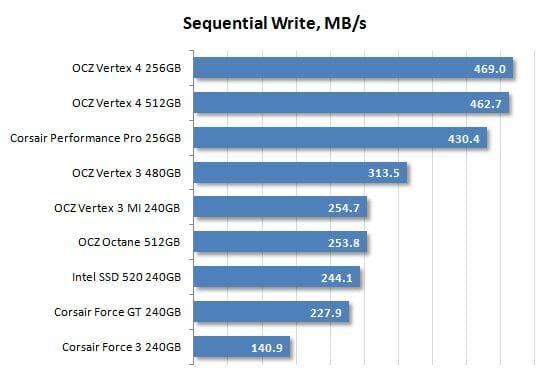
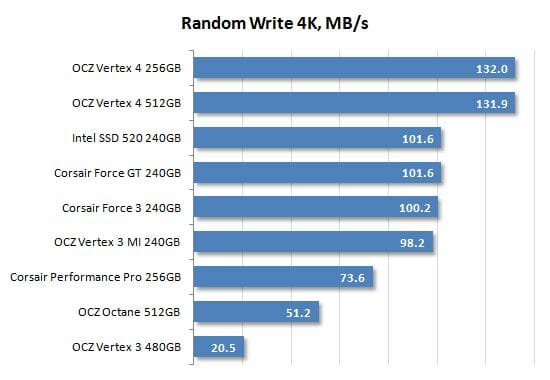
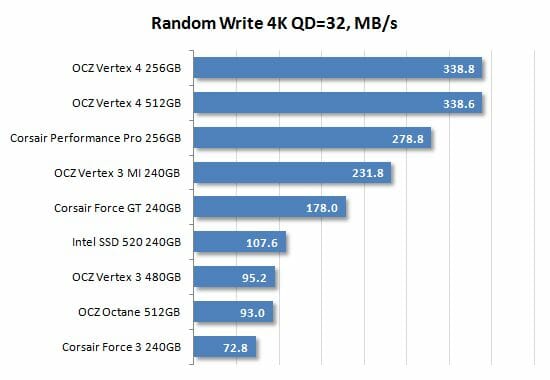
Anyway, the OCZ Vertex 4 series is much better than the rest of the SSDs, many of which have slowed down, in sequential and random writing and at any request queue depth. Take note that the Everest 2 based SSDs are absolutely different from the first-generation Everest. It’s hard to believe that these solutions have something in common.
Futuremark PCMark 7
The popular PCMark 7 contains an individual disk subsystem benchmark. It is not a synthetic test, but is based on real-life applications. This benchmark reproduces typical disk usage scenarios and measures how fast they are completed in popular applications. Moreover, the disk access commands are not executed as a steady uninterrupted flow, but in a more realistic manner – with certain pauses caused by the need to process the data. The benchmark generates an overall disk subsystem performance rating as well as speed readings in MB/s in individual usage scenarios. Note that the absolute speed in these scenarios is not too high because of the above mentioned pauses between individual input/output operations. In other words, PCMark 7 shows you the speed of the disk subsystem from the application’s point of view. Numbers like that show us not only the pure performance of an SSD, but mostly how big of a performance gain a certain SSD can guarantee in real life.
We ran PCMark 7 on “steady” SSDs, which is what they are going to be in actual computer systems most of the time. Their performance in this case is affected not only by their controller or flash memory speed but also by the efficiency of their internal algorithms that fight performance degradation.
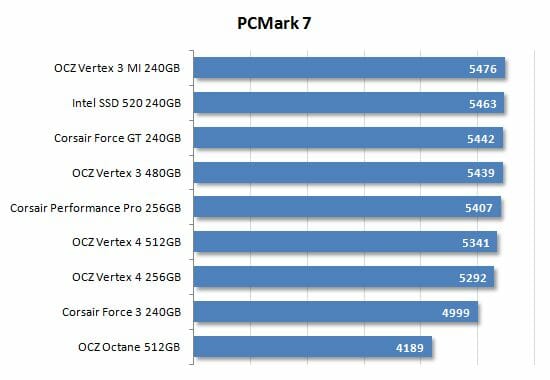
The PCMark 7 score is a good guide for people who don’t want to delve into technicalities but need a simple illustration of relative performance of different SSDs. Here, this benchmark changes our opinion about the new SSDs. Although we praised the high performance of the Vertex 4 series after the synthetic benchmarks, they do not look so good in PCMark 7 which is based on real-life disk usage scenarios. The resulting score is low because of the low speed of sequential reading, which is one of the most popular file access methods in ordinary applications. As a result, the new SSDs from OCZ are slower than the SandForce-based SSDs with synchronous flash as well as the Corsair Performance Pro with its Marvell 88S9174 controller.
Now let’s check out the individual tests to get a more detailed picture of what our SSDs are capable of under various types of operational load:
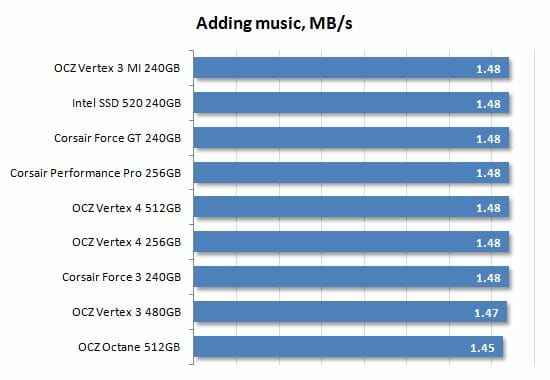
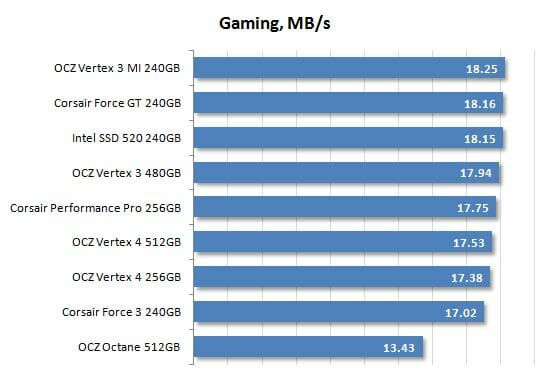
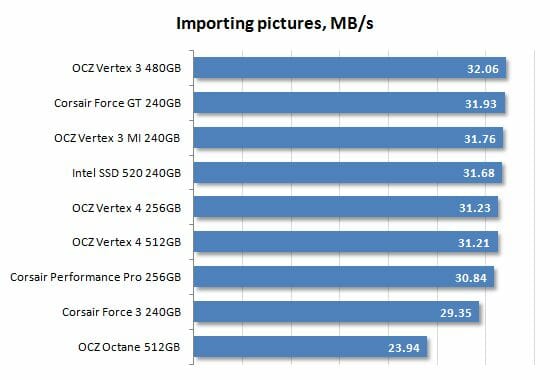
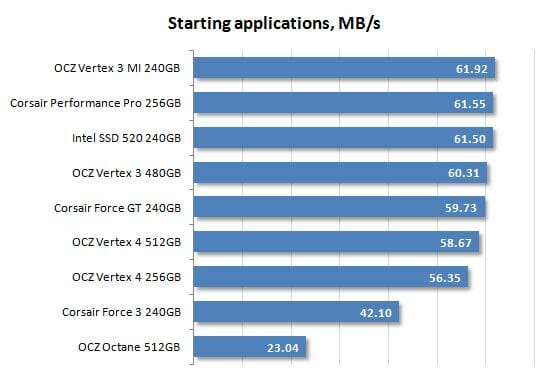
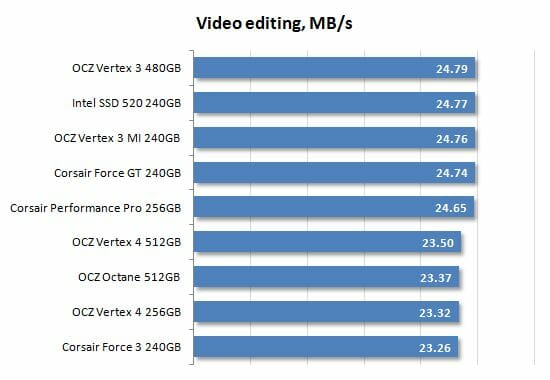
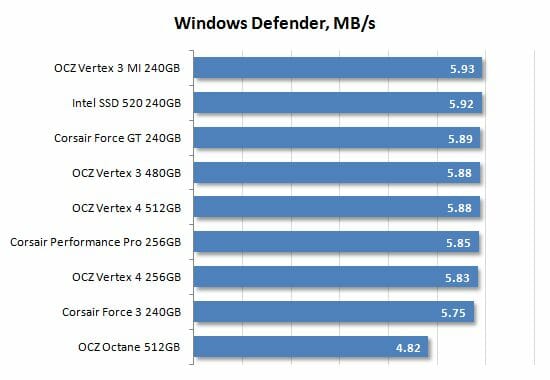
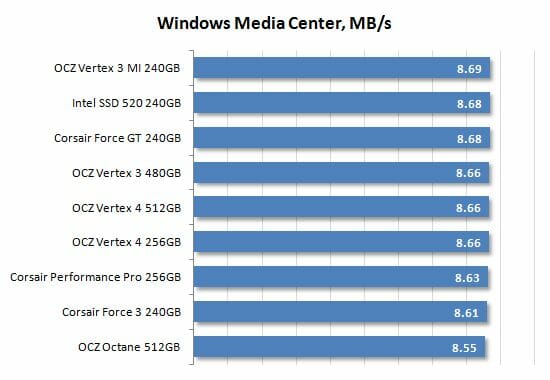
There is no test in which the OCZ Vertex 4 is as impressive as in the synthetic benchmarks. Unfortunately, this SSD is no better than its predecessor Vertex 3 in real usage scenarios. At least, that’s what PCMark 7 says. Let’s see what the other tests can tell us.
Intel NAS Performance Toolkit
Intel NASPT is another disk sub-system test that uses real-life usage scenarios. Like PCMark 7, Intel NASPT reproduces predefined disk activity traces and measures how fast they are executed. However, the default traces are designed for network attached storage devices rather than for SSDs. Therefore during our test session we replace them with the specially developed SSD Benchmarking Suite which offers more relevant usage scenarios such as compressing and decompressing files, compiling large projects, copying files and folders, loading 3D game levels, installing software, batch-processing photos, searching a digital library for data, mass-launching applications, and transcoding video.
Like PCMark 7, this benchmark gives us a true-to-life illustration of disk subsystem performance. Here the SSDs are again tested in their “steady” state.
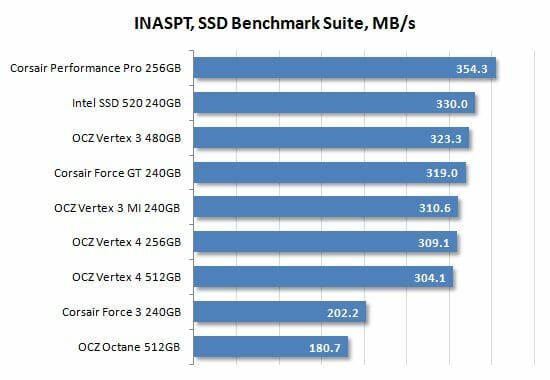
Here is one more test that benchmarks SSDs in real-life usage scenarios, and we have the same results: the Vertex 4 SSDs fall behind the numerous group of modern products based on SandForce and Marvell controllers. It looks like the Vertex 4 can only be welcomed by enthusiasts who are excited by synthetic benchmarks. When it comes to real-life applications, the Everest 2 based SSDs are no better than regular midrange SSDs from other brands. They are hamstringed by their low sequential speed, which is lower even compared to the slow OCZ Octane.
The detailed INASPT results help us see what usage scenarios are the most suitable for our today’s testing participants. Take note that the data-transfer rate is higher than the SATA III interface bandwidth in some subtests. That’s because INASPT is a high-level test that uses standard Windows functions to access the disk subsystem. As a result, the OS caching mechanisms also affect the results.
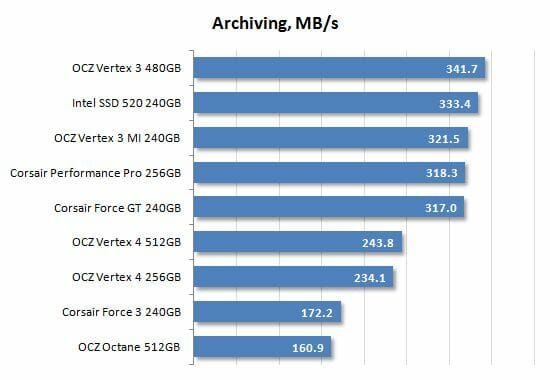
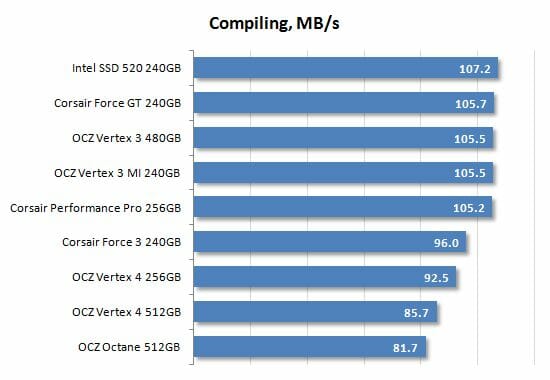
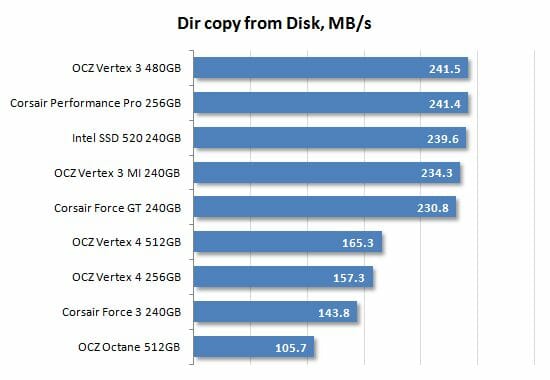
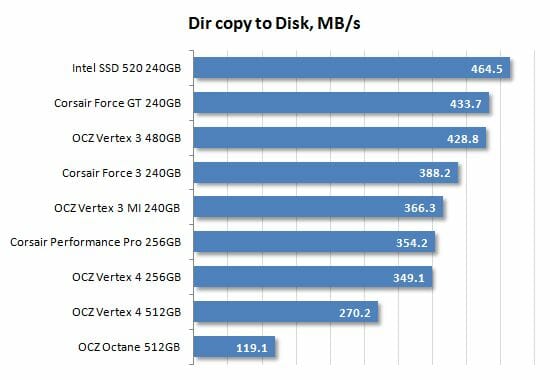
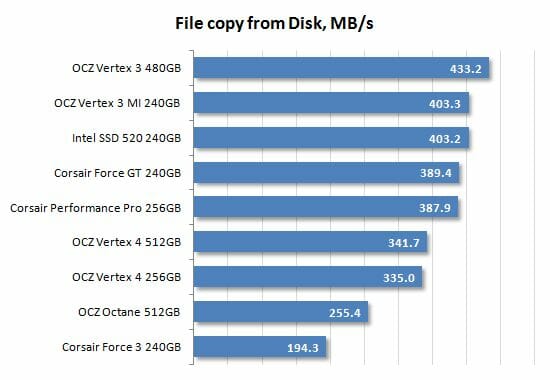
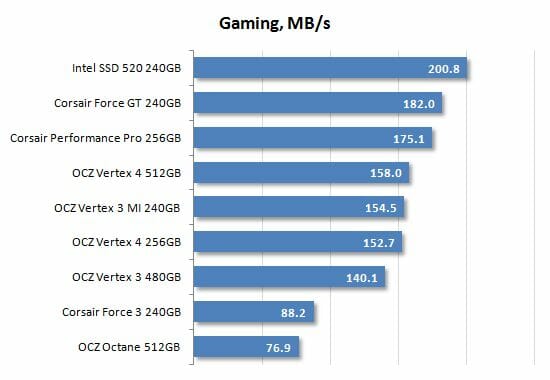
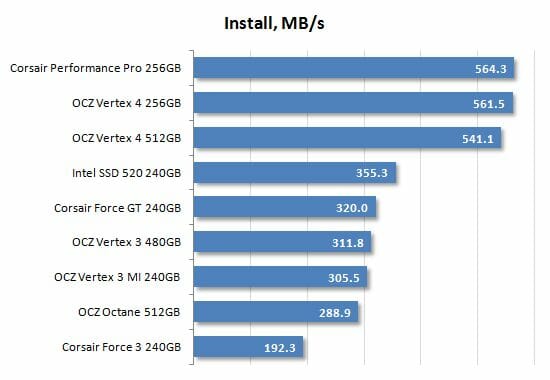
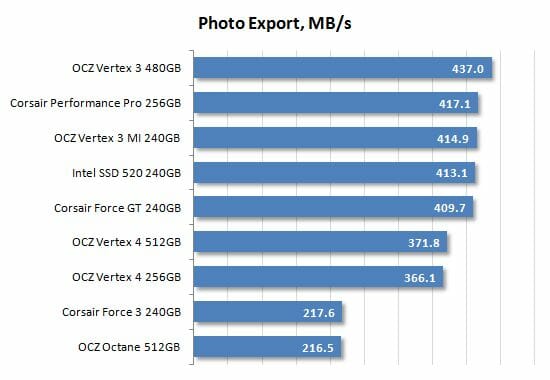
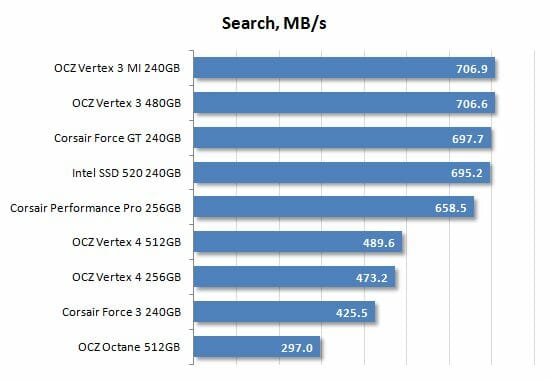
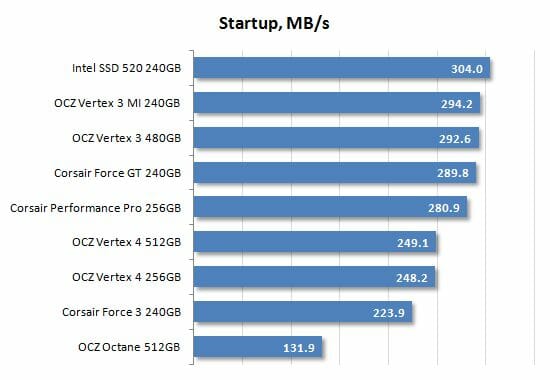
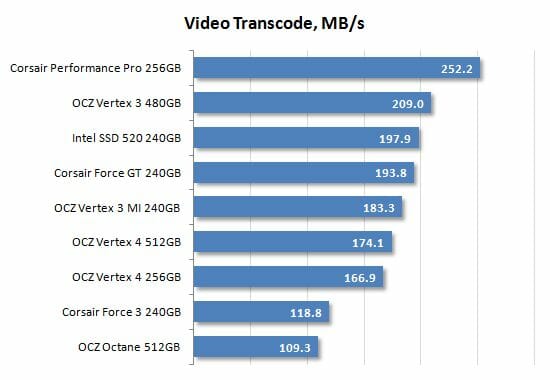
The OCZ Vertex 4 are fast when it comes to writing large files, for example when copying files to the SSD or installing software. Otherwise, this series is just average in performance.
By the way, we can see that the 256- and 512-gigabyte variants are close to each other both in synthetic benchmarks and real applications. The recently released firmware 1.4 has made the 256GB model faster, so it is now occasionally ahead of its 512GB cousin. Theoretically, the 128GB variant should be different, but we can’t check this out right now.
File Copy Speed
We use AS SSD version 1.6.4237.30508 to benchmark the speed of copying files within a single partition the size of the whole SSD. The SSDs are tested in their steady state.
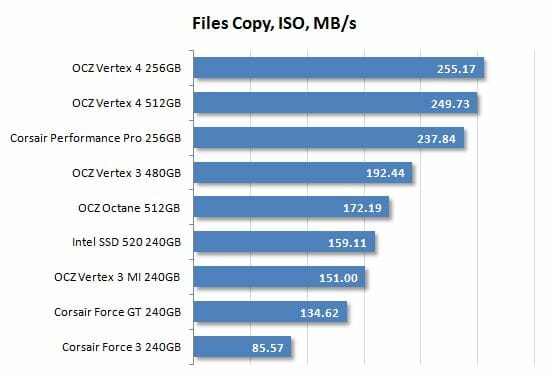
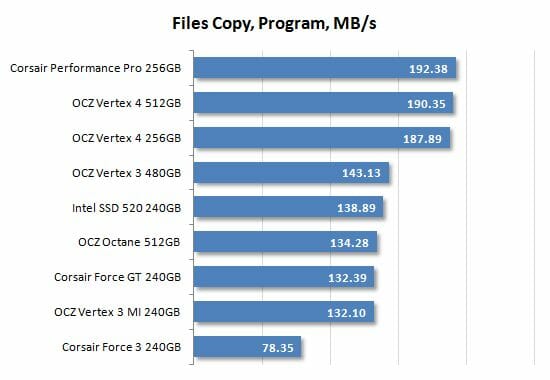
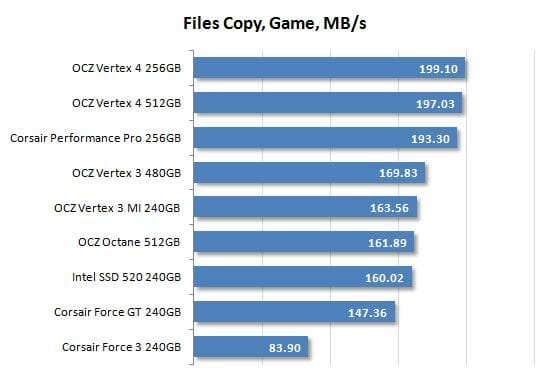
The Vertex 4 could be expected to be fast at copying data thanks to their high write speed we noticed at the beginning of this test session.
Conclusion
OCZ Vertex 4 is undoubtedly a momentous, even epoch-making product for the SSD market at large. And it is not only about its special properties or fantastic performance. The most important thing is that OCZ has joined the club of full-cycle SSD makers that not only solder chips to PCBs and pack them into cases but develop their own controllers and firmware. It took a very short time for OCZ to progress from its tentative Octane to really competitive products falling among the best consumer grade SSDs available out there today. Even though the second generation Everest controllers used in the Vertex 4 were developed in collaboration with Marvell, OCZ’s achievements are impressive indeed.
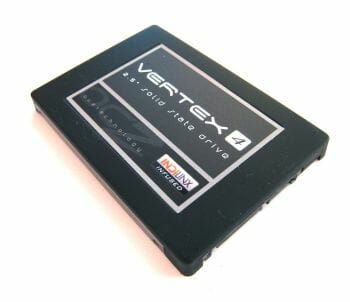
We can’t deny that the new Vertex 4 does have an Achilles heel of its own – sequential data read speed. This Everest 2 based SSD is inferior to almost all its SATA 6 Gbit/s competitors in this aspect. While this issue doesn’t look serious in synthetic benchmarks, it can make the Vertex 4 considerably slower compared to its SandForce and Marvell-based opponents in typical desktop applications. That’s why it is not quite right to consider OCZ vertex 4 a performance leader just yet. It does perform brilliantly in synthetic benchmarks, but in real usage scenarios other than software installation and copying large files Vertex 4 is just a good mainstream product.
At the same time, however, OCZ Vertex 4 is an undefeated leader among SandForce- and Marvell-based SSDs in many respects. The new OCZ drive boasts not only record-breaking write speeds and high performance in case of long request queue depth, but also high-quality TRIM processing and absence of “performance hits” when processing incompressible data. At the same time, different Vertex 4 modifications are priced at a very democratic level and are not much more expensive than the conventional mainstream SSDs, while offering the maximum possible warranty of five years.